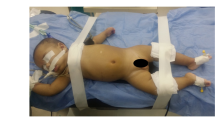Abstract
Introduction
The uretero-pelvic junction (UPJ) is the most common site of obstruction in the pediatric upper urinary tract, causing hydronephrosis. In our institution, the gold standard approach for hydronephrosis in infants is the One-Trocar-Assisted Pyeloplasty (OTAP). The aim of this study is to evaluate the feasibility of OTAP in terms of efficacy and safety in the first 90 days of life.
Methods
We retrospectively reviewed all charts and long-term follow-up of 138 infants treated with OTAP; we selected and examined the ones with a defined diagnosis of severe UJPO and, thus, treated in the first 90 days of life: 28 patients. Indications for early surgery were: antero-posterior pelvic diameter (APD) > 20 mm and an obstructive pattern on renography; impaired echotexture and/or relative renal function < 40% had to be associated.
Results
Out of 23 patients, we witnessed one conversion to open surgery (4.35%) and one recurrence (4.35%) of UPJO. The mean pre-surgery APD was 35.2 mm, while the mean post-surgery APD was 17.32 mm. The mean operative time was 133 min. The mean hospitalization time was 7.71 days. The mean average of follow-up was 46.41 months (minimum 1 year).
Conclusions
Our experience suggests that OTAP is a valid and feasible technique in terms of safety and efficacy for the early treatment of very young infants affected by UPJO.



Similar content being viewed by others
References
Hashim H, Woodhouse CJ (2012) Ureteropelvic junction obstruction. Eur Urol Suppl 11:8
Anderson JC, Hynes W (1949) Retrocaval ureter; a case diagnosed preoperatively and treated successfully by a plastic operation. Br J Urol 21:209–214
Turner RM II, Fox JA, Tomaszewski JJ, Schneck FX, Docimo SG, Ost MC (2013) Laparoscopic pyeloplasty for ureteropelvic junction obstruction in infants. J Urol 189(4):1503–1507
Boylu U, Basatac C, Turan T, Onol FF, Gumus E (2012) Comparison of surgical and functional outcomes of minimally invasive and open pyeloplasty. J Laparoendosc Adv Surg Tech A 22(10):968–971
Lima M, Ruggeri G, Tursini S (2007) One trocar assisted pyelo-plasty (OTAP): initial experience and codification of a technique. Pediatr Med Chir 29:108–111
Lima M, Ruggeri G, Messina P, Tursini S, Destro F, Mogiatti M (2015) One-trocar-assisted pyeloplasty in children: an 8-year single institution experience. Eur J Pediatr Surg 25:262–268
Babu R et al (2019) Hydronephrosis severity score: an objective assessment of hydronephrosis severity in children—a preliminary report. J Pediatr Urol 15(1):68.e1–68.e6
Almodhen F, Jednak R, Capolicchio JP, Eassa W, Brzezinski A, El-Sherbiny M (2010) Is routine renography required after pyeloplasty? J Urol 184(3):1128–1133
Chertin B, Rolle U, Farkas A, Puri P (2002) Does delaying pyeloplasty affect renal function in children with a prenatal diagnosis of pelvi-ureteric junction obstruction? BJU Int 90:72e5
Chertin B, Pollack A, Koulikov D, Rabinowitz R, Hain D, Hadas-Halpren I et al (2006) Conservative treatment of ureteropelvic junction obstruction in children with antenatal diagnosis of hydronephrosis: lessons learned after 16 years of follow-up. Eur Urol 49:734
Longpre M, Nguan A, Macneily AE, Afshar K (2012) Prediction of the outcome of antenatally diagnosed hydronephrosis: a multi-variable analysis. J Pediatr Urol 8:135e9
Babu R, Rathish VR, Sai V (2015) Functional outcomes of early versus delayed pyeloplasty in prenatally diagnosed pelvi-ureteric junction obstruction. J Pediatr Urol 11(63):e1–e5
Garcia-Aparicio L, Blazquez-Gomez E, Martin O, Manzanares A, Garcia-Smith N, Bejarano M, Rodo J, Ribo JM (2014) Anderson-Hynes pyeloplasty in patients less than 12 months old. Is the laparoscopic approach safe and feasible? J Endourol 28:906–908
Tan HL (1999) Laparoscopic Anderson–Hynes dismembered pyelo-plasty in children. J Urol 162:1045
Piaggio LA, Franc-Guimond J, Noh PH, Wehry M, Figueroa TE, Barthold J et al (2007) Transperitoneal laparoscopic pyeloplasty for primary repair of uretero-pelvic junction obstruction in infants and children: comparison with open surgery. J Urol 178(4 Pt 2):1579–1583
Fuchs J, Luithle T, Warmann SW, Haber P, Blumenstock G, Szavay P (2009) Laparoscopic surgery on upper urinary tract in children younger than 1 year: technical aspects and functional outcome. J Urol 182:1561e8
Hao G, Xiao J, Yang P, Shen H (2013) Laparoscopic retroperitoneal dismembered pyeloplasty: single-center experience in China. J Laparoendosc Adv Surg Tech A 23(1):38–41
Autorino R, Eden C, El-Ghoneimi A, Guazzoni G, Buffi N, Peters CA (2014) Robot-assisted and laparoscopic repair of ureteropelvic junction obstruction: a systematic review and meta-analysis. Eur Urol 65:430–452
Jacobson DL, Shannon R, Johnson EK, Gong EM, Liu DB, Flink CC, Meyer T, Cheng EY, Lindgren BW (2019) Robot-assisted laparoscopic reoperative repair for failed pyeloplasty in children: an updated series. J Urol 201(5):1005–1011
Author information
Authors and Affiliations
Corresponding author
Ethics declarations
Conflict of interest
No competing financial interests exist.
Rights and permissions
About this article
Cite this article
Lima, M., Di Salvo, N., Portoraro, A. et al. Feasibility, in terms of efficacy and safety, of video-assisted pyeloplasty (OTAP) in the first 90 days of life. J Ped Endosc Surg 1, 107–112 (2019). https://doi.org/10.1007/s42804-019-00024-x
Received:
Revised:
Accepted:
Published:
Issue Date:
DOI: https://doi.org/10.1007/s42804-019-00024-x




